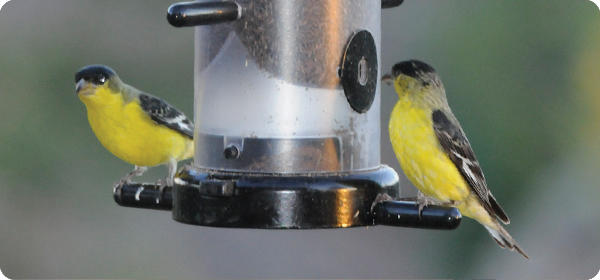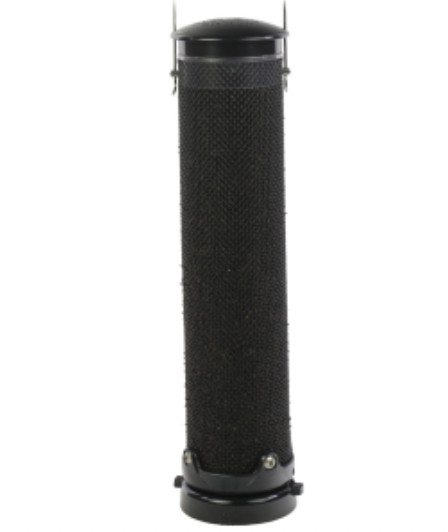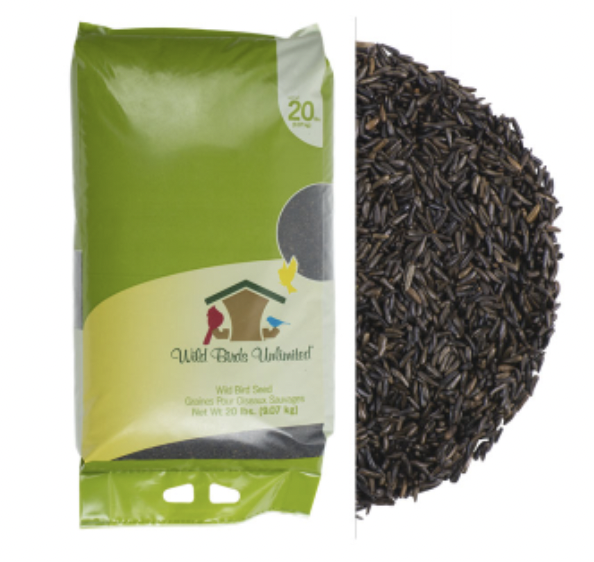
Attract Goldfinches to Your Backyard
Lesser Goldfinches live in the western United States and they are common in and around Santa Fe in the summer months. Though goldfinches carry the reputation of being finicky eaters, you’ll have no problem finding a suitable offering that will please their palate. Goldfinches love to eat fresh Nyjer® (thistle) and sunflower seeds.
They are also easily attracted to fresh water sources. Due to their almost exclusive diet of seeds, the Lesser Goldfinch drinks frequently and will stay close to reliable sources of water, like a bird bath.
Unlike many birds, goldfinches molt their feathers twice a year. They do a partial molt of their feathers in the spring and a complete molt of their feathers in the fall. Unlike their cousin the American Goldfinch which sport vibrant, yellow coats in the spring and duller colors in the fall, the Lesser Goldfinches stay the same coloration year-round.
Like their cousin the American Goldfinch, Lesser Goldfinches will delay breeding until the greatest number of thistle, dandelion and other composite flowers are seeding. This assures a good food source for their nestlings. Additionally, the west coast populations will nest spring into early summer while the more interior populations usually nest mid-to late-summer.
Here are a few items to remember when attracting finches:
- Keep food fresh and dry inside the feeder. Shake the feeder periodically to make sure that the food is dry, and use a Weather Guard to help protect your food from the elements. Make sure the food does not stay in the feeder uneaten for more than three to four weeks.
- Nyjer has a lot of protein and fat that is needed for growing their feathers. Be prepared for increased activity at your feeders in the spring and fall, when goldfinches are molting.
- Once they've fledged, young goldfinches still depend on their parents for food. Watch for these juveniles at your feeders as they beg for food from their parents.
- Use a bird bath and keep the water clean and fresh.
Tips for Successful Goldfinch Feeder Placement
Placing a feeder in the open can leave finches vulnerable to predators. To create a safer environment, position the feeder near a shrub or tree, providing a sense of security and encouraging exploration. Once the finches are accustomed to the feeder, gradually relocate it away from vegetation to deter squirrels if necessary.
Birds, being creatures of habit, may take days or weeks to adapt to a new feeder. Removing other feeders temporarily can prompt them to explore beyond their usual routine. Interestingly, partially filling a new feeder often attracts birds to it.
Blooming flowers and plants producing seeds are particularly enticing. Goldfinches, being granivores, enjoy seeds from various sources such as dandelions, grass, flower heads like Black-Eyed Susans, and occasionally pine cones and certain plant leaves.
Visit the store or call us if you have any additional questions about attracting goldfinches to your yard.
Here is one of our favorite Goldfinch Feeders... come on by the store to see more choices!
EcoClean® Mesh Finch Feeder
Easy to fill, this feeder has advanced product protection embedded in powder coating on the mesh metal tube and all black powder-coated metal components, as well as the plastic seed diverter. Features a removable base, making it easier to clean. The mesh tube allows finches to land and feed wherever they choose. Offer Nyjer, Finch Blend and/or fine sunflower chips.
Goldfinches' Favorite Food... Nyjer
Nyjer® is a high oil content seed, making it an excellent energy source for active birds such as goldfinches, house finches, purple finches and pine siskins.



